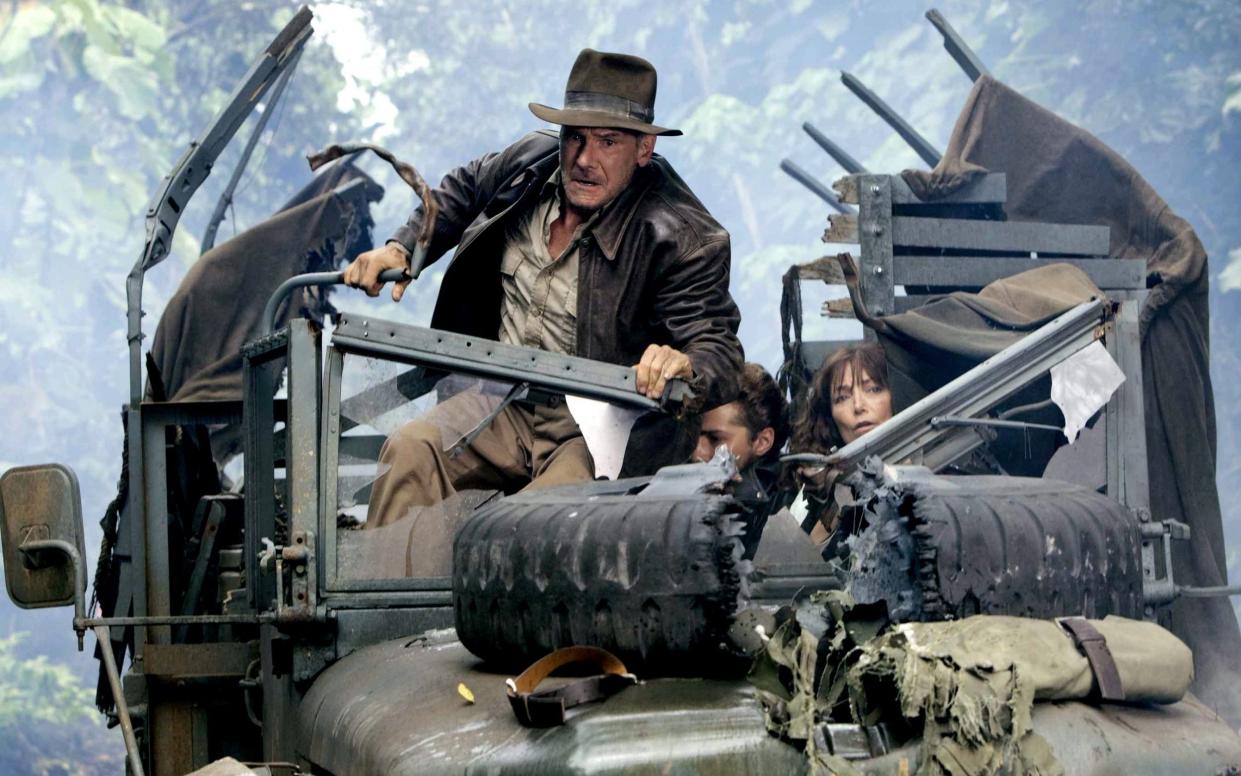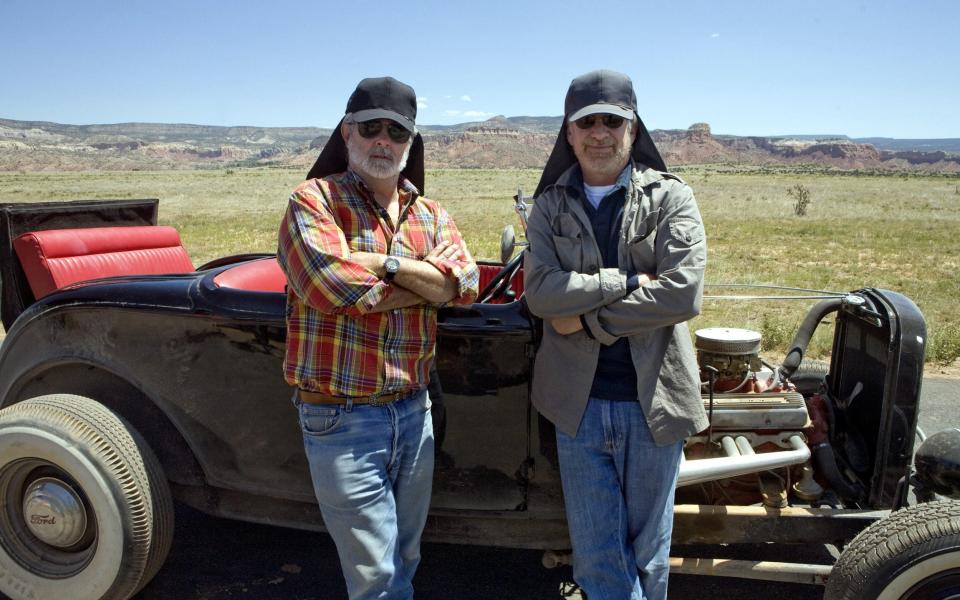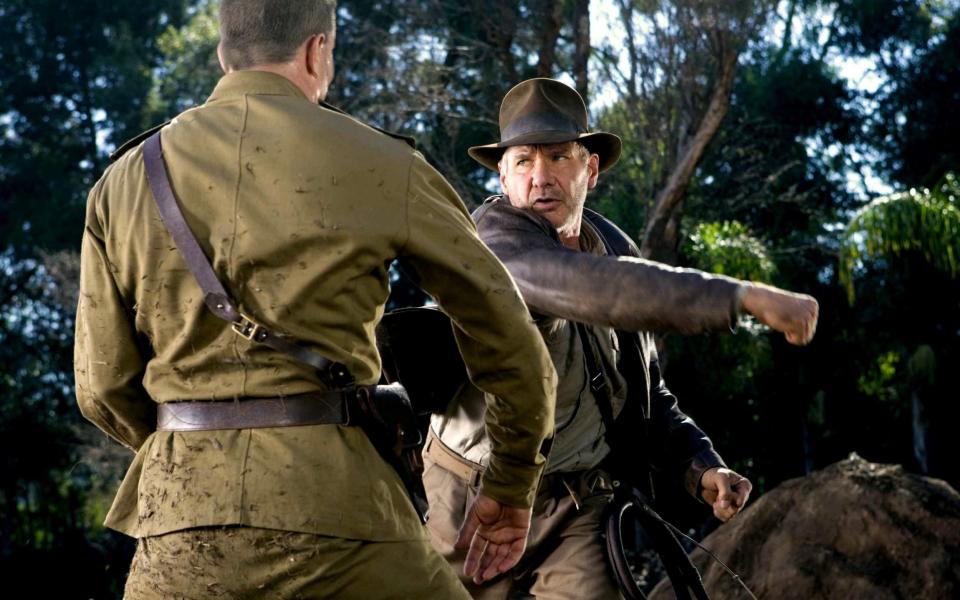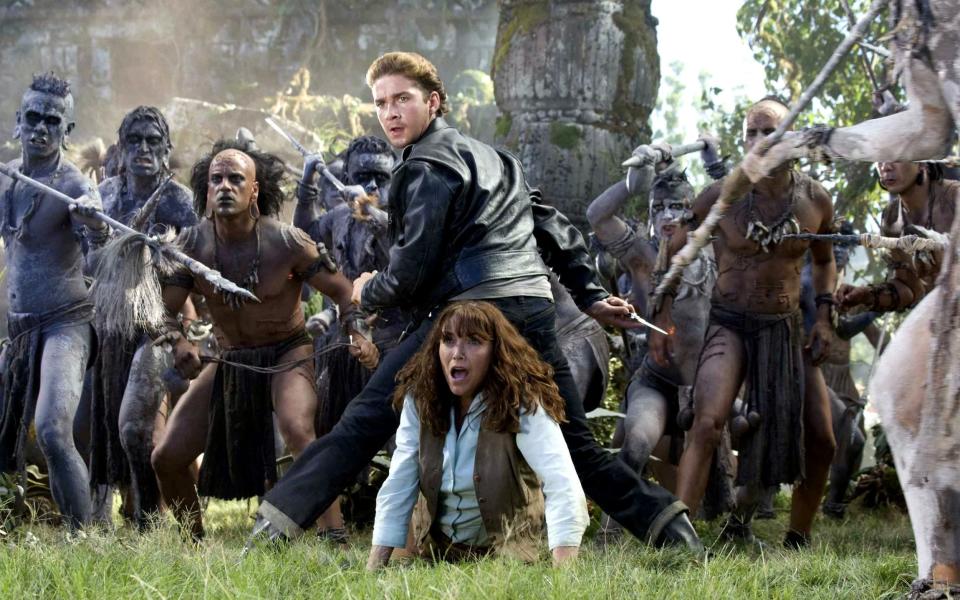‘When you drop the ball you drop the ball’: how Indiana Jones 4 almost nuked Steven Spielberg

Roderick Eric Davis was, officer Brent Hopkins of the Los Angeles Police Department’s burglary department, thought, “an unusual burglar”. Smartly dressed and carrying a messenger bag, Hopkins couldn’t make head nor tail of Davis when the LAPD’s burglary department picked him up after he’d been found hanging around in NBC Universal’s offices in Los Angeles in 2013. “Who knows if he wants to be a producer on the cheap, or has a strange fascination with the film business,” Hopkins said.
This wasn’t the first time Davis had been brought in. Six years before his 2013 arrest, in a hotel room in Los Angeles, Davis met some prospective buyers for some images he’d come into possession of, hoping they might be interested in what he was selling. Then they arrested him.
They were officers from the Los Angeles County Sheriff’s Department, and they informed him that he was being arrested on suspicion of being connected to the theft of “motion picture production budget and proofs” from an office on the Universal Studios complex.
They’d set up a sting operation after detectives learned the pictures were being offered around to gossip websites and any other interested parties. Davis, they alleged, was trying to sell stolen images which gave away clues to the plot of the then-unreleased Indiana Jones and the Kingdom of the Crystal Skull. “We set up a sting and the guy was arrested. It was really great,” producer Frank Marshall told Empire at the time. “People actually said, ‘No, we’re going to respect Steven [Spielberg]’s vision.’”
Such was the feverish anticipation for Indiana Jones’s fourth outing. In the 19 years since Harrison Ford – now 80 – and Sean Connery rode off into the sunset having stopped the Nazis getting their hands on the Holy Grail, attempts to get Indy back on screen had come and gone. That final shot of the third film was very pointed.

“I thought that brought the curtain down on the trilogy, and then we were all going to move on and mature into other aspects of filmmaking and I never thought I would see Indiana Jones again,” Spielberg said during the Crystal Skull promo rounds. Nevertheless, Spielberg, George Lucas and Ford talked occasionally in the early Nineties about what to do with Indy next, and always found themselves at odds. “Every once in a while a script would show up and it wouldn't be exactly what we hoped for one or the other of us,” Ford told Empire. “It took us all a long time to get on the same page.”
Spielberg was particularly wary. “I was the holdout,” Spielberg said later. “I was the one that said, ‘I’m done with this series, it was great, let’s walk away.’” For the long-awaited fifth instalment, Indiana Jones and the Dial of Destiny – premiering in Cannes on May 18, released on June 30 and starring a partially de-aged Harrison Ford – Spielberg has handed the reins to Logan director James Mangold. He can only improved on Crystal Skull.
It was Lucas’s idea to shift the action into the Cold War, paying homage not to the action-adventure serials of the Thirties but the sci-fi B-movies of the Fifties. Spielberg dug his heels in. “I said, ‘George, I don’t want to do aliens.’ I’d already done two alien movies. At the time I’d done ET and Close Encounters of the Third Kind. I didn’t want to do any more aliens. That was it. But George insisted.”
The first draft was titled Indiana Jones and the Saucer Men; later it became Indiana Jones and the Attack of the Giant Ants, and Indiana Jones and the Mysterians. Even then, Spielberg thought he was “humouring” Lucas’ pet project, and vaguely anticipated throwing it to a younger director if it ever went anywhere. When Roland Emmerich’s Independence Day was a huge alien-based smash, Spielberg assumed that was that. They couldn’t do another massive alien invasion film now, he reasoned.
But Lucas wouldn’t give up, and eventually came up with a compromise. These aliens weren’t aliens at all – they were interdimensional beings, he told Spielberg, and launched into an explanation of string theory. Out of a sense of duty to his old friend, and slightly worn down, Spielberg relented. “OK: these are interdimensional beings,” he said. “They’re not extraterrestrial, they’re interdimensional. Fine, fine. What are they going to look like? George said, ‘Well, like aliens. But we’ll call them interdimensional.’”
Ford returned as Indiana Jones at the age of 64, attempting to stop the Russians getting their hands on a crystal skull so they could control the world’s populace telepathically. Every precaution was taken to prevent leaks. When he was asked to play Indy’s old war buddy Mac, Ray Winstone insisted on seeing a script. The production eventually allowed them to, but only by sending a member of staff from America bearing a single hard copy to his house.
Winstone then had a couple of hours to read the script once, with the courier sitting in the room. As soon as Winstone was finished, the courier left with the script and headed straight for the airport.
Despite Spielberg’s disquiet, the shoot went smoothly. But there was one thing the production couldn’t control. The build-up to the release of Crystal Skull saw one of the earlier examples of fans swapping scraps of information and homebrewed theories about a film’s plot on the internet long before it actually arrived. With a lack of detail on what Crystal Skull would actually entail, the film’s tie-in Lego sets, released well in advance of the film itself, became oracles of what fans could expect.
Every tiny plastic piece was scrutinised and discussed at length, though the “River Chase” and “Jungle Cutter” sets revealed little other than that snakes would make their usual appearance, and that they’d be aided and abetted by giant ants.
A third set, based on the climax at the Mayan temple, was more helpful. Despite the attempts to keep things secret, fans worked out early on that the mini-figurines which looked like translucent skeletons were aliens and that the telltale Lego scowl on Cate Blanchett’s figurine meant she would turn out to be a villain. Spielberg was upset by the early reveals, but Lucas was more philosophical.

“Steven will say, ‘Oh, everything's out on the internet – what this is and what that is,’” he later said. “And to that I say, ‘Steven, it doesn't make any difference!’ Look, Jaws was a novel before it was a movie, and anybody could see how it ended. Didn’t matter.”
Leaks kept coming though. Actor Tyler Nelson had been cast as a Russian soldier who celebrated Jones’s capture by dancing to balalaika music, and was apparently so excited he gave an interview to the Edmond Sun, his hometown newspaper in Oklahoma. “Apparently the Soviet army was searching for a skull in the jungles of South America and Indiana Jones was searching as well,” Nelson said.
Tyler then blabbed that the Russians would blackmail Jones by threatening to kill Marion, the mother of his son Mutt, and that Blanchett – who had remained totally silent about what her involvement would entail – played an evil Russian operative. “I saw Harrison Ford strapped to a chair and being interrogated,” he added cheerily. The production team took a dim view, and a Supreme Court order which charged him with violating a confidentiality agreement was settled out of court. Nelson’s balalaika dancing was reportedly cut from the finished film.
Though some reviews were lukewarm, Crystal Skull set a new mark for Indiana Jones at the box office with $790 million taken worldwide. But the moment that leapt out of Crystal Skull was one which had been floating around in the back of Spielberg’s head since he’d executive produced Back to the Future.
The original ending of Bob Gale and Robert Zemeckis’s script saw Marty McFly and Doc Brown sending Marty back to 1985 not with a lightning strike to the Hill Valley clock tower, but by driving the DeLorean straight into the blast zone of a nuclear bomb test and riding the explosion home.

The sequence would have entailed building and then destroying a “nuketown” – a collection of buildings in different styles and materials populated by mannequins which was used to measure the damage a bomb could do to a typical American town – and was dropped when an extra $1 million had to be knocked off the budget.
It was worked into Crystal Skull and much remained exactly the same: the bomb dropping from a metal tower; a dash around a perfect, clapper-boarded model home full of dummies; a montage of plastic people melting horrifically as the bomb’s fireball engulfs the town. The pay-off, though, was that Jones would survive a multi-megaton nuclear bomb and temperatures hotter than the surface of the sun by clambering into an empty lead-lined fridge.
When the film came out, critics and fans were quick to point out that even if Indy had managed to avoid being vaporised by the blast, he’d probably have struggled to avoid being turned into mush when the fridge was thrown hundreds of metres away from the explosion.
Soon, the phrase “nuking the fridge” had overtaken “jumping the shark” as a way of describing something collapsing under the weight of its own ludicrousness. “I’m proud of that,” Spielberg said. “I’m glad I was able to bring that into popular culture.”
Spielberg tried to shield Lucas from blame for the scene, but Lucas told the New York Times that it was the other way around; Spielberg wasn’t sure, but Lucas liked it so much he compiled a six-inch-thick dossier of evidence that Indy wouldn’t have been carbonised or pulverised. “The odds of surviving that refrigerator – from a lot of scientists – are about 50-50,” Lucas insisted.
After a drawn-out birth, there was a drawn-out aftermath to Crystal Skull too. Spielberg admitted to being less than thrilled with the way it panned out. There were “big arguments” between the two friends about the crystal skulls and their powers, he said later. “I didn’t want these things to be either aliens or interdimensional beings,” he said. “But I am loyal to my best friend. When he writes a story he believes in – even if I don't believe in it – I'm going to shoot the movie the way George envisaged it.”
The crystal skulls were still causing headaches after the film came out. They’re said by some to be ancient artefacts made by Mayan communities, though recent examinations have shown them to be 20th-century hoaxes. One academic from Belize took issue with the film co-opting them.

In 2012, Dr Jaime Awe, an expert in Mayan culture and archaeology who taught at universities in Canada and the United States, filed a lawsuit against LucasFilm, Disney and Paramount Pictures because in his view Hollywood was exploiting Belizean culture for “illegal profits”. The crystal skulls of Crystal Skull were, he thought, designed after a skull “found” in Belize in 1924 by English adventurer FA Mitchell-Hedges.
“LucasFilm never sought, nor was given permission to utilise the Mitchell-Hedges Skull or its likeness in the film,” the lawsuit said. “Driven by its success in theaters, both LucasFilm and Paramount continue to profit from the continued distribution of the Film on home media and online video sources. To date, Belize has not participated in any of the profits derived from the sale of the Film or the rights thereto.” The suit was eventually dismissed.
Even if he was unhappy, Spielberg expected his cast to stay on message. Shia LaBeouf, who played Indy’s greaser son Mutt, did exactly the opposite in an LA Times interview at Cannes in 2010. “We [Harrison Ford and LaBeouf] had major discussions. He wasn’t happy with it either. Look, the movie could have been updated. There was a reason it wasn’t universally accepted.”
He was particularly critical of a sequence in which Mutt swung on vines through the jungle canopy with dozens of monkeys. “I think he’s [Spielberg’s] a genius, and he’s given me my whole life. He’s done so much great work that there’s no need for him to feel vulnerable about one film. But when you drop the ball you drop the ball.”

LaBeouf’s disinclination to defend the film irked Spielberg. “He told me there’s a time to be a human being and have an opinion, and there’s a time to sell cars,” LaBeouf later said. “It brought me freedom, but it also killed my spirits because this was a dude I looked up to like a sensei.” The director he found was “less a director than he is a f______ company,” LaBeouf said.
Ford sided with Spielberg and let LaBeouf know it. “I think he was a f______ idiot,” Ford told Details in 2011. “As an actor, I think it’s my obligation to support the film without making a complete ass of myself.”
LaBeouf was unrepentant. “I remember him [Spielberg] saying to me, ‘Tom Cruise never picks his nose in public,’” Laboeuf told Interview. “And all I thought was, I don’t want to be Tom Cruise.”
Ford has steadfastly refused to pick his nose over Crystal Skull, though a short snort when the film came up in a Vanity Fair interview perhaps said more than he meant it to. “I really enjoyed each of the films and the different experiences I had in each of the films,” he said diplomatically, “and the people that I worked with.”


